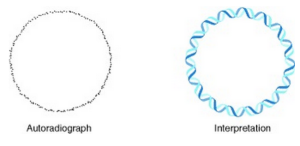3.1 Developments in scientific research follow improvements in technology—gene sequencers are used for the sequencing of genes.
3.2 Developments in research follow improvements in techniques—autoradiography was used to establish the length of DNA molecules in chromosomes.
Perhaps no other area of biology has benefited so greatly from technological advances than genetics. Our knowledge and understanding of inheritance has increased dramatically over the last 50 years as technology had allowed us to delve ever deeper into the mysteries of our genes and our evolution.
The Gene Sequencer has made possible the ability to determine the order of As, Ts, Cs and Gs in any genome and was essential to decoding the Human Genome Project. The breakthrough Sanger Sequencing technique from 1975 has been adapted and updated to provide rapid and inexpensive gene sequencing information. There is a good overview of how they work at the Scitable Page, including a short video. There are strong links to the process of DNA replication; in fact, the method of gene sequencing relies on manipulating replication. It is worth remembering, however, that sequencing only allows us to see the sequence of bases, it does not tell us about the genes themselves. Thus sequencing is only the first step in understanding how the genome functions.
On a smaller scale, but no less important, was John Cairns’ breakthrough in 1963 using autoradiography. Using radioactively labelled thymidine (the nucleoside using thiamine as its base) he examined bacterial DNA during and after DNA replication. After the the radioactive bases were incorporated into the cells, he lysed them and then prepared slides using X-ray film. They took two months to develop! This technique is known as Autoradiography. It was used by the Curies for some of their work on radioactivity, but its use for biological purposes really became apparent after World War 2, when it was used extensively to investigate RNA and DNA.
Cairns was able to interpret his images as providing evidence of the bacterial circular chromosome and of showing the movement of the replication fork around the chromosome.


(Griffiths AJF, Miller JH, Suzuki DT, et al. 2000)
The autoradiographs also allowed the first estimates of chromosomal length. By measuring the lengths of the radiated bases within the chromosome, an estimate could be achieved; in this 1100 µm.
When newer and more advanced technologies are invented, what will change about our understanding of the world? What do we hold true today that might turn out to be false tomorrow? To what extent is knowledge fixed in the natural sciences?
References
Adams, J. (2008) DNA sequencing technologies. Nature Education 1(1):193 http://www.nature.com/scitable/nated/article?action=showContentInPopup&contentPK=690
Cairns, J. 1980. The bacterial chromosome and its manner of replication as seen by autoradiography. Current Contents: Life Sciences. (29): 20-20. http://www.garfield.library.upenn.edu/classics1980/A1980JY54900001.pdf#search=%22John%20Cairns%20DNA%22
Griffiths AJF, Miller JH, Suzuki DT, et al. An Introduction to Genetic Analysis. 7th edition. New York: W. H. Freeman; 2000. Replication of DNA. Available from: http://www.ncbi.nlm.nih.gov/books/NBK21790/
Griswold, A. (2008) Genome packaging in prokaryotes: the circular chromosome of E. coli. Nature Education 1(1):57
One thought on “3.1 Genes, 3.2 Chromosomes and Technology”